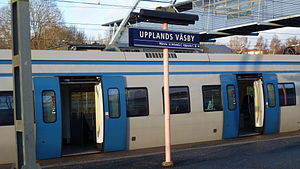Upplands Väsby railway station
| Pendeltåg | |||||||||||||||||||
 | |||||||||||||||||||
| General information | |||||||||||||||||||
| Location | Stockholm County | ||||||||||||||||||
| Coordinates | 59°31′15″N 17°53′57″E / 59.52083°N 17.89917°E | ||||||||||||||||||
| Owned by | Swedish Transport Administration | ||||||||||||||||||
| Platforms | 2 | ||||||||||||||||||
| Tracks | 2 | ||||||||||||||||||
| Connections | Bus terminal | ||||||||||||||||||
| Construction | |||||||||||||||||||
| Structure type | At-grade | ||||||||||||||||||
| Other information | |||||||||||||||||||
| Station code | Upv | ||||||||||||||||||
| History | |||||||||||||||||||
| Opened | 1866 | ||||||||||||||||||
| Passengers | |||||||||||||||||||
| 2022 | 7,700 boarding per weekday[1] (commuter rail) | ||||||||||||||||||
| Services | |||||||||||||||||||
| |||||||||||||||||||
Upplands Väsby is a station on the Stockholm commuter rail network, located 24.4 km north of Stockholm Central Station. It is the only station within Upplands Väsby Municipality, situated between Rotebro and Rosersberg stations. The station has two platforms and two ticket halls, with the northern hall accessed via an underpass and the southern hall connected to the bus terminal. A small depot is located north of the station, used for storing commuter train carriages. As of 2022, the station has an average of 7,700 boardings per weekday.[2]
History
[edit]The original station, initially named Väsby, opened in 1866 when the Northern Main Line (now part of the Ostkustbanan) was inaugurated.[3] In 1907, it became the terminus for local trains from Stockholm. In 1939, the station name was changed to its current one to avoid confusion with names like Näsby or Visby. The postal service had made a similar change twenty years earlier, and in 1952, the name was adopted by the Upplands Väsby Municipality.[4]
In 1967, SL took over the responsibility for local public transport within Stockholm County, introducing modern commuter train services and prompting the station’s renovation. Further renovations took place in the 1980s and 1990s, when the track was expanded to four tracks. From 2006 to 2012, Upptåget had its southern terminus at Upplands Väsby, which led to the addition of temporary wooden platforms.[5]
Gallery
[edit]References
[edit]- ^ https://www.regionstockholm.se/4a2748/contentassets/d6c4da12e11843c0ab8249c297dfd8fe/fakta-om-sl-och-lanet-2022.pdf
- ^ https://www.regionstockholm.se/4a2748/contentassets/d6c4da12e11843c0ab8249c297dfd8fe/fakta-om-sl-och-lanet-2022.pdf
- ^ "Förr i tiden". www.hembygd.se (in Swedish). Retrieved 2025-02-20.
- ^ "Norra stambanan". www.stiglundin.se. Retrieved 2025-02-20.
- ^ Lindblom, Maria (2009-09-23). "SL-tåg till Uppsala på väg att bli verklighet". www.unt.se (in Swedish). Retrieved 2025-02-20.
- Hällqvist, Arne (2008). Pendeltåg i stockholmsområdet. TNF bok; 62. Trafik-Nostalgiska Förlaget. ISBN 978-91-85305-65-0. LIBRIS: 10672321.
- Harlén, Hans (2016). Pendeltågen. TNF bok; 217. Trafik-Nostalgiska Förlaget. ISBN 978-91-87695-49-0.











